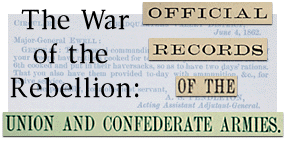Summary:
In April, 1862, General George B. McClellan's Army of the Potomac planned an
advance on Richmond by way of the James River Peninsula. At the same time,
Nathaniel Banks' Federals, stationed in the Valley, faced Jackson's troops. In
this letter McClellan writes Banks regarding the plans and situation in the
Valley. He suggests an advance on Staunton once railroad communications make it
possible.
HEADQUARTERS ARMY OF THE POTOMAC,
Maj. Gen. N.P. BANKS,
Commanding Fifth Corps:
On board the Commodore
April 1, 1862.
GENERAL:
The change in affairs in the valley of the Shenandoah has rendered necessary a corresponding departure--temporarily at least--from the plan we some days since agreed upon. In my arrangements I assume that you have with you a force amply sufficient to drive Jackson before you, provided he is not re-enforced largely. I also assume that you may find it impossible to detach anything toward Manassas for some days, probably not until the operations of the main army have drawn all the rebel force toward Richmond.
You are aware that Gen. Sumner has for some days been at Warrenton Junction, with two divisions of infantry, six batteries, and two regiments of cavalry, and that a reconnaissance to the Rappahannock forced the enemy to destroy the railway bridge at Rappahannock Station, on the Orange and Alexandria Railroad. Since that time our cavalry have found nothing on this side of the Rappahannock in that direction, and it seems clear that we have no reason to fear any return of the rebels in that quarter. Their movements near Fredericksburg also indicate a final abandonment of that neighborhood. I doubt whether Jonston will now re-enforce Jackson with a view to offensive operations; the time has probably passed when he could have gained anything by doing so. I have ordered in one of Sumner's divisions (that of Richardson, late Sumner's) to Alexandria for embarkation. Blenker's has been detached from the Army of the Potomac and ordered to report to Gen. Fremont.
Abercrombie is probably at Warrenton Junction to-day; Geary at White Plains.Two regiments of cavalry have been ordered out and are now on the way to relieve the two regiments of Sumner.
Four thousand infantry and one battery leave Washington at once for Manassas; some 3,000 more will move in one or two days, and soon after some 3,000 additional.
I will order Blenker to march on Strasburg and to report to you for temporary duty, so that, should you find a large force in your front, you can avail yourself of his aid. As soon as possible please direct him on Winchester, thence to report to the Adjutant-Gen. of the Army for orders, but keep him until you are sure what you have in front.
In regard to your own movements the most important thing at present is to throw Jackson well back and then to assume such a position as to enable you to prevent his return. As soon as the railway communications are re-established it will be probably important and advisable to move on Staunton, but this would require secure communications and a force of from 25,000 to 30,000 for active operations. It should also be nearly coincident with my own move on Richmond; at all events not so long before it as to enable the rebels to concentrate on you and then return on me. I fear that you cannot be ready in time, although it may come in very well, with a force less than that I have mentioned, after the main battle near Richmond. When Gen. Sumner leaves Warrenton Junction Gen. Abercrombie will be placed in immediate command of Manassas and Warrenton Junction under your general orders. Please inform me frequently by telegraph and otherwise as to the state of things in your front.
I am, very truly, yours,
GEO. B. McCLELLAN,
Maj.-Gen., Commanding.
Bibliographic Information : Letter Reproduced from The War of The Rebellion: Official Records of the Union and Confederate Armies, Series 1, Volume 12, Serial No. 15, Pages 234-235, Broadfoot Publishing Company, Wilmington, NC, 1997.

